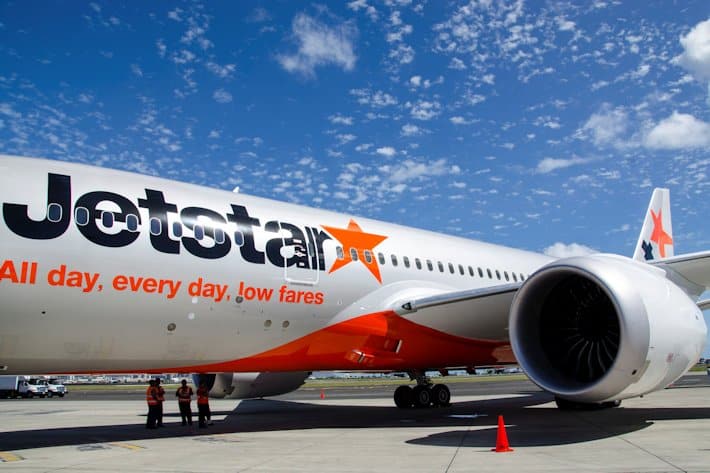Aerospace
Jetstar named the world’s worst airline

Jetstar has been branded the worst airline in the world, after receiving one star out of five for overall customer satisfaction.
Some 37.2 per cent of Jetstar passengers complained about delays to their flights – with the average wait time being four hours after the scheduled departure time.
The international survey, organised by the watchdog Choice and 10 other consumer groups, had 11,273 respondents, who ranked the Australian airline 73rd for overall satisfaction.
Customers from Australia, Belgium, Brazil, Denmark, France, Italy, Portugal and Spain were surveyed and asked to score airlines on punctuality, check in, boarding, treatment by staff, comfort, meals, safety and value for money.
Jetstar’s primary rival, Tigerair, was not included in the survey, as there were not enough responses from customers. This was questioned by Jetstar’s spokesperson, who told the Daily Mail Australia: “Choice seem to enjoy criticising airlines without understanding the safety standards we operate to or recognising the role of low cost carriers in making travel more affordable for millions of Australians.
“There are a lot of holes in this latest Choice survey, including leaving out our main competitor Tiger because they didn’t collect enough responses, so the veracity of the report is questionable.
“We know how important it is to get customers to their destination on time, and we recognise there is room for improvement and our team is doing a lot of work behind the scenes.
“Weather is often the source of delays, particularly in the more tropical destinations we operate to, and we’ll always put safety before schedule.”
Emirates was revealed as the best airline in the world from the survey, with a satisfaction rating of 8.29 out of 10, swiftly followed by Avianca, Qatar Airlines, Luxair and Singapore Airlines.
TOP 10 AIRLINES FOR CUSTOMER SATISFACTION (SCORE OUT OF 10)
1. Emirates 8.29
2. Avianca 8.17
3. Qatar Airlines 8.15
4. Luxair 8.1
5. Singapore Airlines 8.1
6. Azul Brazilian 8.08
7. Thai Airways International 8.02
8. Cathay Pacific 7.94
9. TAROM 7.79
10. Vietnam Airlines 7.79
Source : independent U.K.

Aerospace
Boeing Transfers Rocket Stage to NASA, Paving Way for Human Moon Mission

Boeing has achieved a significant milestone by providing NASA with the second core stage of the Space Launch System (SLS) rocket.
This crucial component, crafted at NASA’s Michoud Assembly Facility (MAF), is set to propel the Artemis II crew into lunar orbit, marking humanity’s return to deep space after a 50-year hiatus.
The monumental Boeing-built rocket stage, the largest element of the Artemis II mission, will embark on a journey aboard the Pegasus barge, traveling 900 miles to NASA’s Kennedy Space Center.
Comparison of two legendary aircraft B777x vs B747 aircraft:Click here
Upon arrival, it will be meticulously integrated with other essential Artemis II components, including the upper stage, solid rocket boosters, and NASA’s Orion spacecraft within the iconic Vehicle Assembly Building. This intricate integration process is a vital step toward the eagerly anticipated Artemis II launch, slated for 2025.
“Boeing-built products helped land humankind on the moon in 1969, and we’re proud to continue that legacy through the Artemis generation,” remarked Dave Dutcher, vice president and program manager for Boeing’s SLS program. “Together, with NASA and our industry partners and suppliers, we are building the world’s most capable rocket and paving the way to deep space through America’s rocket factory in New Orleans.”
NASA, Lockheed Martin Reveal X-59 Quiet Supersonic Aircraft:Click here
The delivery of Core Stage 2 marks a significant achievement in the evolution of the SLS rocket. Towering over 200 feet and powered by four RS-25 engines, this core stage, coupled with two solid-fueled booster rockets, will generate a staggering 8.8 million pounds of thrust. This immense power is crucial to launching Artemis II and future missions into the vast expanse of space.
The SLS rocket stands unparalleled in its capability to transport both crew and substantial cargo to the moon and beyond in a single launch. Its extraordinary capacity will facilitate the delivery of human-rated spacecraft, habitats, and scientific missions to destinations including the moon and Mars, ushering in a new era of space exploration.
-

 Travel1 week ago
Travel1 week agoAir India to Expand US Operations with Three New Routes After a Decade
-

 Travel2 weeks ago
Travel2 weeks agoWhy We Should Avoid These Stamps in a Passport
-

 Airlines1 month ago
Airlines1 month agoInvestigations Reveal Fake Chinese Titanium in Boeing and Airbus Jets
-

 Tech4 weeks ago
Tech4 weeks agoChina’s CATL Plans 1,800-Mile Electric Plane Launch by 2027
-

 Airport3 days ago
Airport3 days agoTop 10 Largest Airports in the World by Size
-

 Aerospace4 weeks ago
Aerospace4 weeks agoChina’s Fighter Jets Turn Wings into Autonomous Drones
-

 Airlines4 days ago
Airlines4 days agoAir India Rolls Out A350s for Delhi-New York JFK and Newark Routes
-

 Defence3 weeks ago
Defence3 weeks agoBoeing Enhances Chinook with New Engines and Block II Upgrades at $96 Million







